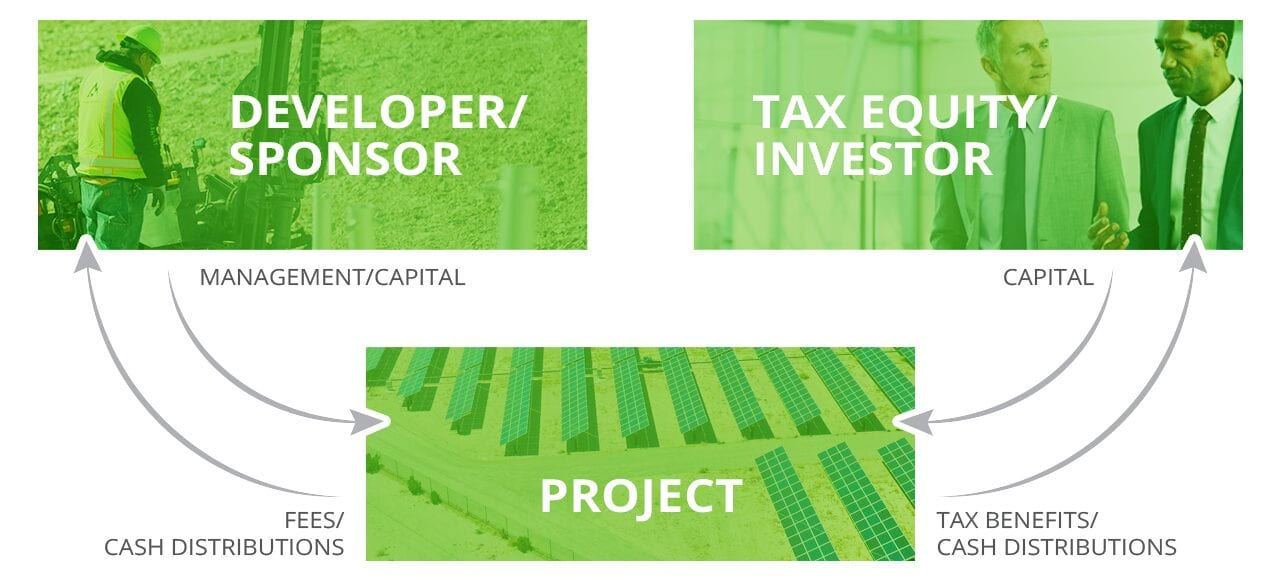Tax equity is an essential—and growing—component of renewable energy investing. According to Norton Rose Fulbright’s Project Finance NewsWire, tax equity investment in wind and solar facilities in the US comprised a roughly $13 billion market in 2019, and was estimated to reach $15 billion in 2020. That’s a lot of capital being put to work in a sustainable industry.
How Does Tax Equity Work?
Created by the federal government to drive investment in clean energy, tax equity in renewables allows investors, such as commercial banks, to offset taxable income earned elsewhere when they invest in sustainable energy projects. This gives investors the opportunity to not only reduce their tax liability, but also generate cash returns.
Since these entities have the expertise to evaluate the quality of a project and ensure it will be profitable enough to provide tax advantages, they can also help project sponsors (like Greenbacker) make the best decisions about which projects to buy and how to structure the most mutually beneficial transactions. Moreover, tax equity investors can also provide ongoing project oversight and monitoring. In other words, everyone involved stands to gain.
The government offers two key incentives for renewable energy projects:
- An investment tax credit (ITC), which currently stands at 26% for residential, commercial, and utility investors in solar energy properties.
- A production tax credit (PTC) of up to $0.025/kWh for wind, closed-loop biomass, and geothermal facilities.
The ITC was recently extended through 2022 and is scheduled to step down to 22% in 2023 unless the government opts to renew the existing credit. The current PTC has been extended as well, through at least the end of this year. However, as with the ITC, the PTC can again be renewed and/or expanded—as they have been many times before.
To qualify for the credit, tax equity investors must have an ownership interest in the underlying physical investment. This requirement is met by investors entering into a limited partnership agreement (meaning it does not have an active management role), in which they invest slightly more than the cash equivalent of the credit in exchange for a return (e.g., 1%–2% p.a.) on its initial investment amount. At the end of the investment period—typically five or six years—the project sponsor/owner will buy the tax equity investor out at the remaining value of its equity interest in the partnership.

Source: Congressional Research Service
For example, within the first year of a typical tax equity investment, investors receive approximately 80% of their capital back in the form of the tax credit and tax-deductible depreciation. Any unused tax credits or tax-deductible depreciation can be carried forward and used to offset their future tax liability. The investors will also continue to receive a preferred cash flow return every year for the next five years until they’re bought out. While the tax credits typically expire after five or six years of facility operation, wind and solar facilities don’t need these over the long term, as they can continue generating cash flows to cover any debt payments and provide attractive investor returns.
A Synergistic Relationship
Due to Greenbacker’s successful track record in the industry, we have been able to secure over $100 million in tax equity commitments from commercial banks. Our experience and streamlined processes allow us to both put these deals together quickly and buy more projects using our existing capital. As mentioned earlier, the research provided by our tax equity investors also helps inform our decisions regarding which projects we get involved with and how we can best structure our transactions.
This, in turn, has made us extremely attractive to developers, who typically lack the time and resources needed to find and engage investors. Working with us allows them to simply focus on building and selling renewable energy facilities. Because they know the value of coming to us for financing, these developers also tend to bring us future projects.
Due to the economic impact of the global pandemic, fewer new tax equity investors are entering the market, resulting in tax equity supply no longer keeping up with solar project growth. This means that tax equity investors are prioritizing only the highest-quality solar projects with the most reputable sponsors—and favoring those with whom they’ve successfully done business in the past. As a trusted industry partner, Greenbacker is able to attract these investors, allowing us to secure a pipeline of profitable new projects from experienced developers, and create a win-win situation for all parties involved.
Disclosure
This information has been prepared solely for informational purposes and is not an offer to buy or sell or a solicitation of an offer to buy or sell any security, or to participate in any trading or investment strategy. If any offer of securities is made, it will be pursuant to a definitive offering memorandum prepared by Greenbacker Capital Management LLC (“Greenbacker”) that contains material information not contained herein and that supersedes this information in its entirety. Any decision to invest in the strategy described herein should be made after reviewing a definitive offering memorandum, conducting investigations, and consulting the investor’s own investment, legal, accounting, and tax advisors in order to make an independent determination of the suitability and consequences of an investment. Greenbacker does not provide tax advice. Investors are urged to consult with their own tax advisors regarding an investment in the strategy described herein and the realization of any tax benefits. The information presented herein may involve Greenbacker’s views, estimates, assumptions, facts, and information from other sources that are believed to be accurate and reliable and are, as of the date this information is presented, subject to change without notice.
Securities offered through WealthForge Securities, LLC, Member FINRA/SIPC. Greenbacker Capital LLC and WealthForge Securities, LLC are separate entities.
There are material risks associated with investing in alternative investments, including financing risks, general economic risks, long hold periods, and potential loss of the entire investment principal. Potential cash flow, returns, and appreciation are not guaranteed. This is not a solicitation or an offer to see any securities. Please read the Private Placement Memorandum (PPM) in its entirety, paying careful attention to the risk section prior to investing.
The shares of limited liability company interests of Greenbacker Renewable Energy Company LLC, a Delaware limited liability company, have not been registered under the U.S. Securities Act of 1933, as amended (the “Securities Act”) or approved by the Securities and Exchange Commission (the “SEC”) or any state securities agency. This is a private offering made only pursuant to exemptions provided by Section 4(a)(2) of the Securities Act, Rule 506(b) of Regulation D promulgated thereunder and applicable state securities laws. Neither the SEC nor any state agency has passed upon the value of the shares, made any recommendations as to their purchase, approved or disapproved this offering. Any representation to the contrary is a criminal offense.

